

For the fourth day of the trip, I would be crossing the border east into Quebec and visiting the second-largest city in Canada: Montreal. This is a hilly city that sits atop a large island in the Saint Lawrence River, with its oldest portions dating back to the early days of New France. Montreal has historically been a highly diverse urban area, with peoples from all different parts of the world choosing to live in this bilingual and highly educated urban center. Montreal is actually the second-largest French-speaking city in the world after Paris, and serves as a hub for the unique Quebecois version of French Canadian language and identity. This is a city much too big to visit in a single day, although as usual I was going to take my best shot at seeing as many sights as possible in the span of less than 24 hours.
The drive from Ottawa to Montreal was shorter than the last few car trips I had done, this early morning excursion taking about 2.5 hours to drive the 200 kilometers (125 miles) east from the Canadian national capital. It was a quiet drive for the most part, with Canadian highway 417 taking a lonely route through picturesque small towns in the eastern edge of Ontario. It wasn't until I crossed the Saint Lawrence and entered the western suburbs of Montreal that the traffic picked up again. I was able to park my car at the hostel where I would be staying, a place just to the south of the historic city center. From this spot, I would be doing a lot of walking to see as much of the city as possible. An awful lot of walking on a very hot day outside.


As chance would have it, the hostel where I was staying was located only a few blocks away from the Bell Centre, or Centre Bell as it's called more properly in French. This arena is home to the Montreal Canadiens, the professional hockey team that commands the hearts and minds of the city's fans. The Canadiens have been playing hockey since the early 20th century and are one of the Original Six teams of the NHL. Unlike the downtrodden Toronto Maple Leafs, the Montreal Canadiens have been the most successful hockey team in the history of the NHL, winners of a staggering 24 Stanley Cup championships. To be fair a lot of those were won back in the days when only six teams were competing in the league, but the Canadiens still won another dozen titles in the expansion era as well. At the time of this writing in 2018, they hadn't won a Stanley Cup since the end of the 1993 season, an interminable length of time for a fanbase accustomed to winning the league on an almost annual basis. It should go without saying that the Canadiens are widely detested by virtually every other NHL fanbase due to their success, and the recent spate of mediocre teams has been met with considerable schadenfreude from the rest of the league. I was only able to see the outside of the Bell Centre during my visit as I passed by, and I would have liked to stop to visit the inside more closely. This is the largest dedicated hockey arena in the world with over 21,000 seats, and it's supposed to be an amazing place to visit on a game night.


A short distance east of the Bell Centre is a pair of small parks, Dorchester Square and Canada Place. These play host to the usual green spaces and a pair of statues, one of them dedicated to Sir John Alexander Macdonald and the other one memorializing Canadians who fought in the Boer War in South Africa. That's probably a pretty obscure monument these days to anyone who isn't a British imperial historian. I appreciated the flower beds in the parks, which provided a nice splash of bright color in the middle of the urban landscape.


These parks sit adjacent to a large church known as Mary Queen of the World Cathedral (Cathédrale Marie-Reine-du-Monde), one of those names that flows more smoothly in French than it does in English. This is a Catholic church modeled after St. Peter's Basilica in Rome and serves as the seat of the Roman Catholic archdiocese of Montreal. It is not the largest church in the city, with that honor going to Saint Joseph's Oratory a bit further out from the city center on the southern slopes of Mont Royal. Mary Queen of the World Cathedral was built in the late 19th century to replace an earlier Catholic church that had been destroyed by fire, and it was completed in 1894 after two decades of construction. The architectural style on the exterior was inspired by the Renaissance, with those classical columns along the front entryway, but the church also contains a standard Baroque dome in a bronzed green color. This was the most significant historical landmark in this section of the city, and I headed inside to view the structure from the interior.

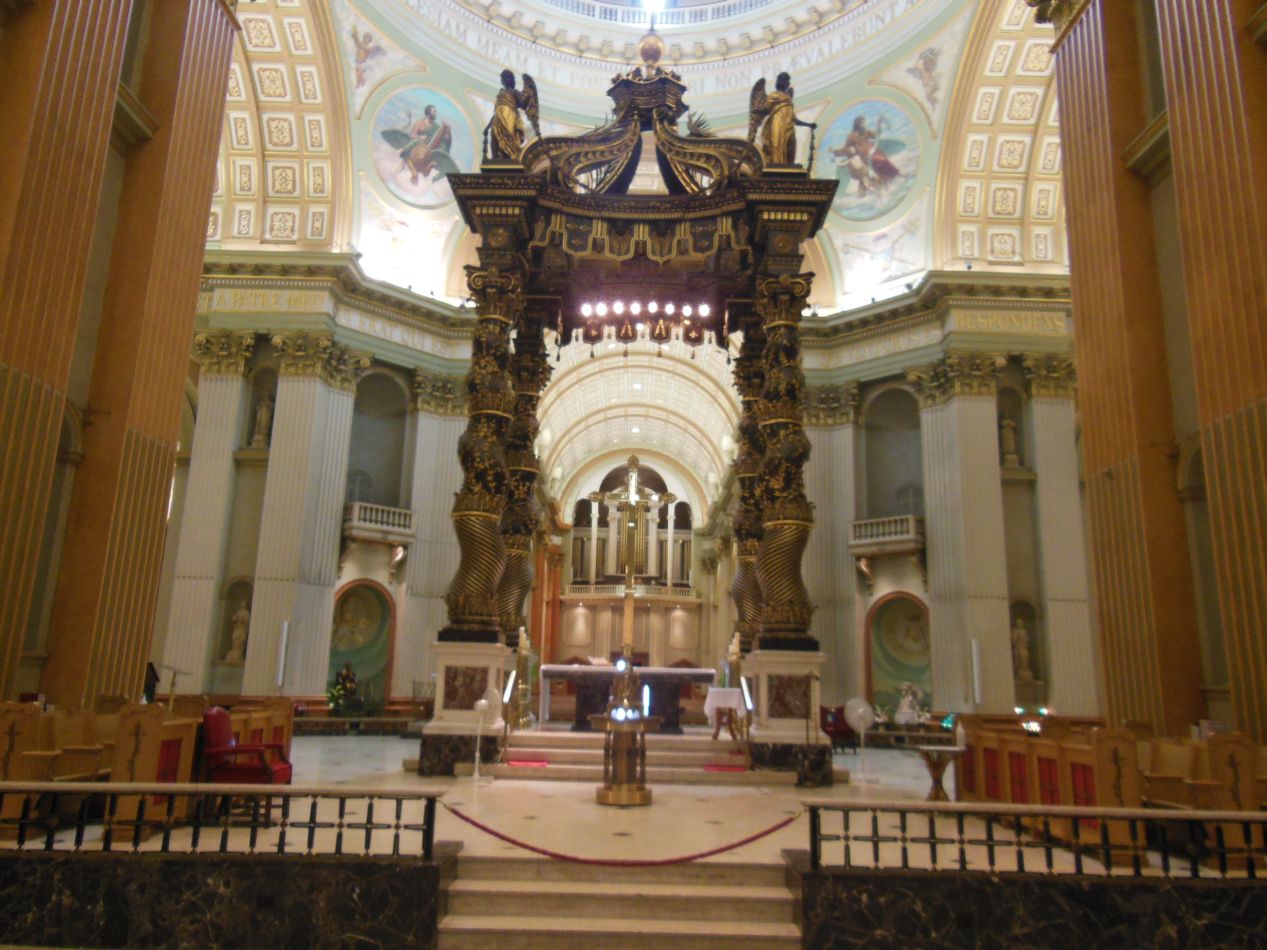


Mary Queen of the World Cathedral was almost completely empty inside, a pattern that I've seen over and over again when touring religious houses of worship. The scant handful of visitors were treated to a bright and warm interior, however, with tall ceilings that seemed to swallow up the individual people walking about. There were relatively few windows on display here and almost no stained glass at all, but the building's designers worked around this with lots of electrical lights that lit up the interior like it was noon. The central altar was where the inspiration (imitation?) provided by St. Peter's Basilica was most evident, with the tall and twisty structure pictured above rising up above the central dais. I had seen virtually the exact same thing a few years earlier when I was in Rome and had the chance to visit St. Peter's. According to the Internet, this is known as a "ciborium" and is defined as a freestanding canopy or covering supported by columns that stands over and covers the altar in a basilica or other church. The thing certainly stood out from the rest of the place. Overall, Mary Queen of the World Cathedral was a quiet sanctuary in the middle of a bustling city. It looks to be little used outside of Sunday services.




Further to the east of the cathedral was the oldest part of the city, known as Vieux-Montréal or in English simply as "Old Montreal". (Readers of this will have to forgive me if I overuse some of the French terms since I'm a serious Francophile.) The old part of the city dates back to its founding in the middle of the 17th century, with Paul Chomedey de Maisonneuve founding the original European settlement in 1642. This is an area with narrow streets that snake about in no clear pattern, built up against the river where ships used to load and unload cargoes of timber and furs. The Old Montreal district was nearly demolished on several occasions in the 20th century to make it more amenable to cars, but ultimately the area was preserved and now functions as the center of the city's tourist industry. It's thoroughly pleasurable to stroll around on the brick and cobblestone streets, taking in the sights and exploring some of the many shops and restaurants that cater to visitors. This particular day was partly cloudy and warm, perfect weather for summer tourists to enjoy the city.


The focal point of the Old Montreal district is the Place d'Armes, the historic town square located in the heart of the oldest buildings. This is the home to Notre Dame Basilica of Montreal (Basilique Notre-Dame de Montréal), the city's most famous and recognizable church. It's also the location of a well-known statue of Maisonneuve, depicted in an old-fashioned triumphalist colonial pose with sword on hip and French flag extended. This is what most people think of when imagining the early history of the city, instead of the ramshackle collection of fur traders scrounging off the charity of nearby First Nations groups that actually charaterized the initial decades of New France. The Place d'Armes is also a magnet for Montreal's tourist attractions, with more gift stores and horse-drawn carriages collected around the square than anyone could ever need. While it wasn't terribly busy on this particular Thursday morning, the afternoon crowds were already beginning to gather.
I headed inside the Basilica, which I had visited on a previous trip to Montreal in the summer of 2007. The sight inside still took my breath away:




Notre Dame Basilica of Montreal has a unique French Canadian design that combines standard Gothic elements together with local touches. It was the inspiration for the Notre-Dame Cathedral of Ottawa that I had visited the previous day, but the imitator was nowhere near as impressive as the original. Notre Dame Basilica of Montreal was built during the 1820s, as usual established on the same location as an older church that the city's populace had outgrown and was no longer large enough to service the Montreal community. Unusually for a church, the stained glass windows on the exterior walls do not depict religious scenes, instead telling the early history of the city of Montreal. The key distinguishing feature of the basilica are the gold stars on a field of blue that adorn the ceiling. In fact, almost everything on the inside seemed to be decorated in some shade of either blue or gold; as befitting a Catholic place of worship, this is a colorful and vibrant house of worship. The altar has more of the same blue and gold motif going on, with the central crucifix ringed by statues of saints. At the rear of the church above the entrance is a huge pipe organ, once again hanging beneath that canopy of stars. If I'm being perfectly honest, this place definitely leans towards the gaudy side, and there's probably an excessive of gold trim covering many of the surfaces of this church. However, I can't help but like the design of Notre Dame Basilica of Montreal. I love the consistent use of the same colors, and I enjoy the feeling of being underneath a starry night sky. This place is instantly recognizable, and the pictures that I have here, taken with a cheap digital camera, don't really do it justice.

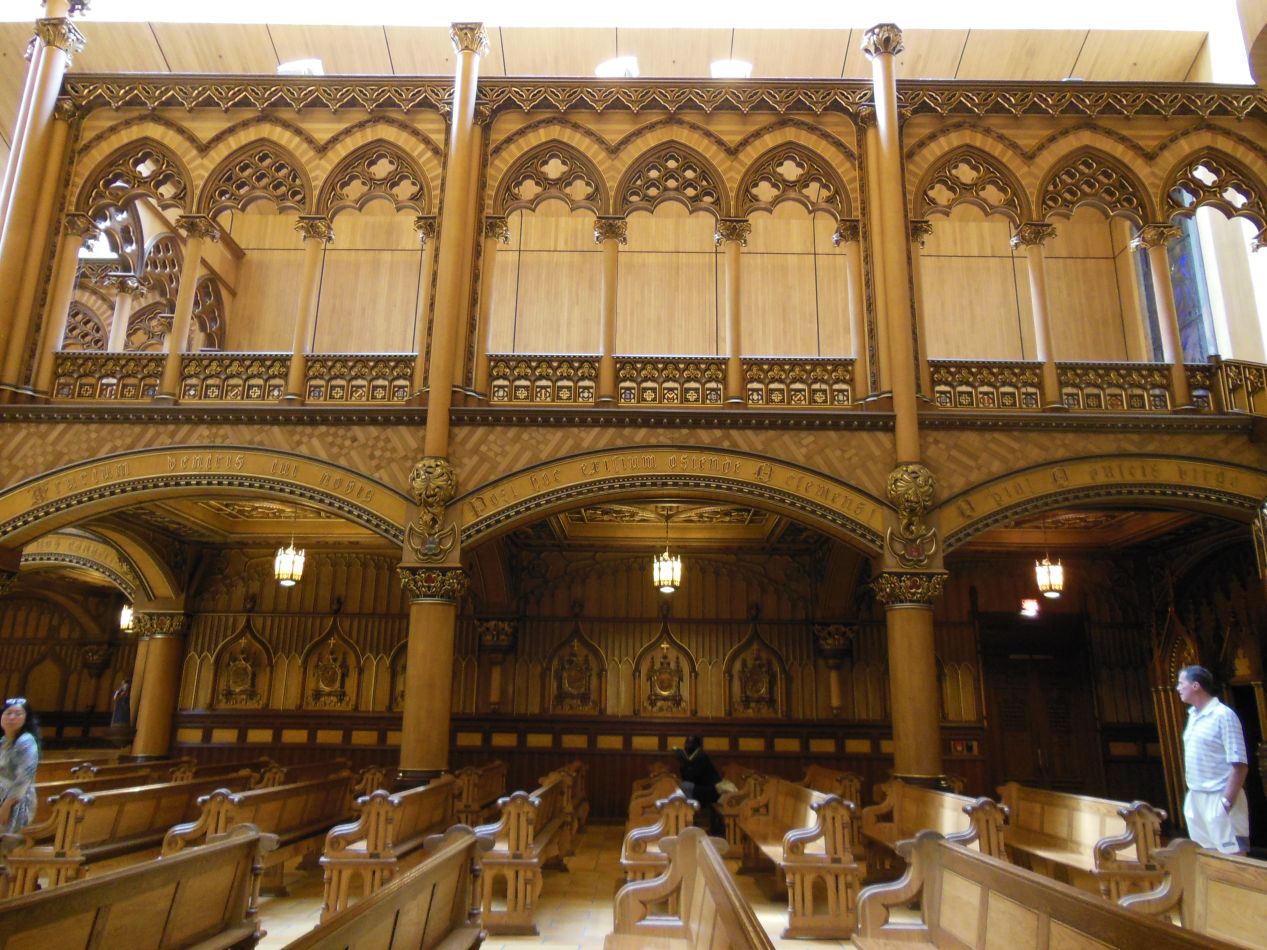


In addition, there's another chapel located in the back of the Basilica that looks completely different. Known as the Sacred Heart Chapel (Chapelle Notre-Dame du Sacré-Coeur), this is a much more modern piece of construction added after the original chapel was destroyed in a fire that took place in 1978. The chapel uses a striking all-wooden design theme, and whereas everything in the main church wants to overwhelm the visitor with royal colors of blue and gold, this chapel employs softer earth tones of brown and yellow. The main altar has some kind of New Age interpretation of Christianity depicted behind it, which would be totally out of place in the older part of the church but fits well here. My favorite aspect of the entire chapel was the pair of AMAZING spiraling staircases in the back that led up to the second floor seating areas. Those things looked like they came out of a video game or an artist's sketchbook, not real life. Whoever was the architect here did a spectacular job.  I didn't even know that this chapel existed and didn't visit it the last time that I toured the Basilica, so this was one of those lucky finds that you sometimes stumble into while traveling. This place was awesome to see.
I didn't even know that this chapel existed and didn't visit it the last time that I toured the Basilica, so this was one of those lucky finds that you sometimes stumble into while traveling. This place was awesome to see.

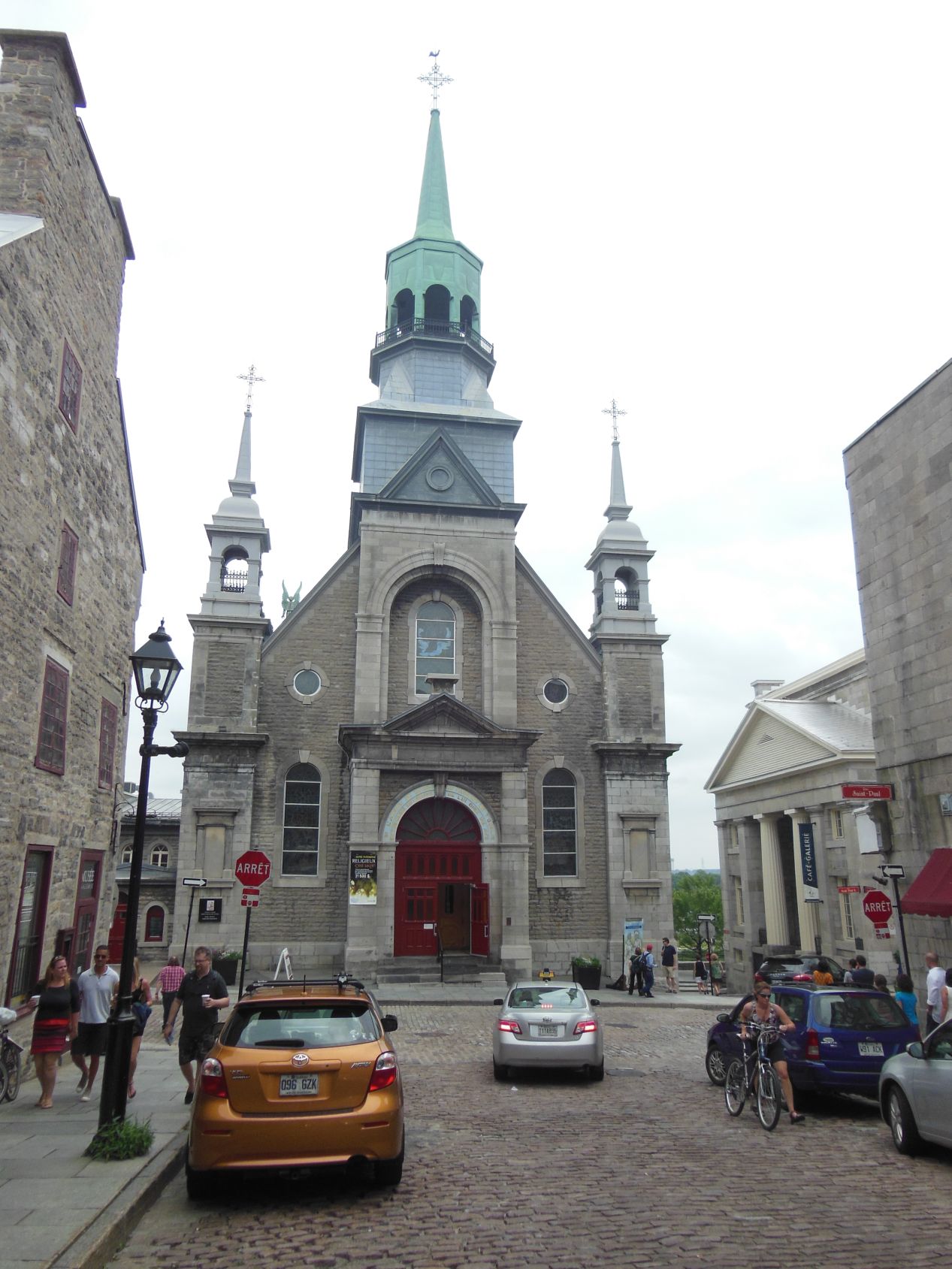


While I was still in the heart of Old Montreal, I stopped to see some other less famous sights in the area. The first of these was Bonsecours Market, or Marché Bonsecours as the picture indicates above. This building dates back to the 1840s and served for a long time as the main public market for the city of Montreal. I was unimpressed when I visited, however; in 2013 the building contained only high-end luxury retailers, and there wasn't much for me to see here, not unless I wanted to purchase expensive designer apparel. The market stood right next to something else that did interest me though: Notre-Dame-de-Bon-Secours Chapel, the oldest surviving church in the city of Montreal. There was a church of some kind on this spot dating back to 1655 shortly after the city's founding, and the current structure dates back to the late 18th century when ground was broken in 1771. Notre-Dame-de-Bon-Secours is a small church and easily overshadowed by some of its more recent and larger compatriots. It was specifically built to cater to sailors who plied the river nearby, with the current chapel highlighting this history by having small ship models hang down from the ceiling on strings. On my visit, the small interior was brightly light through the stained glass windows on the outside, and for once there were a few parishioners inside saying some prayers. Although I wouldn't have gone too far out of my way to visit this spot, it was worth the quick stop since I was already in the area.

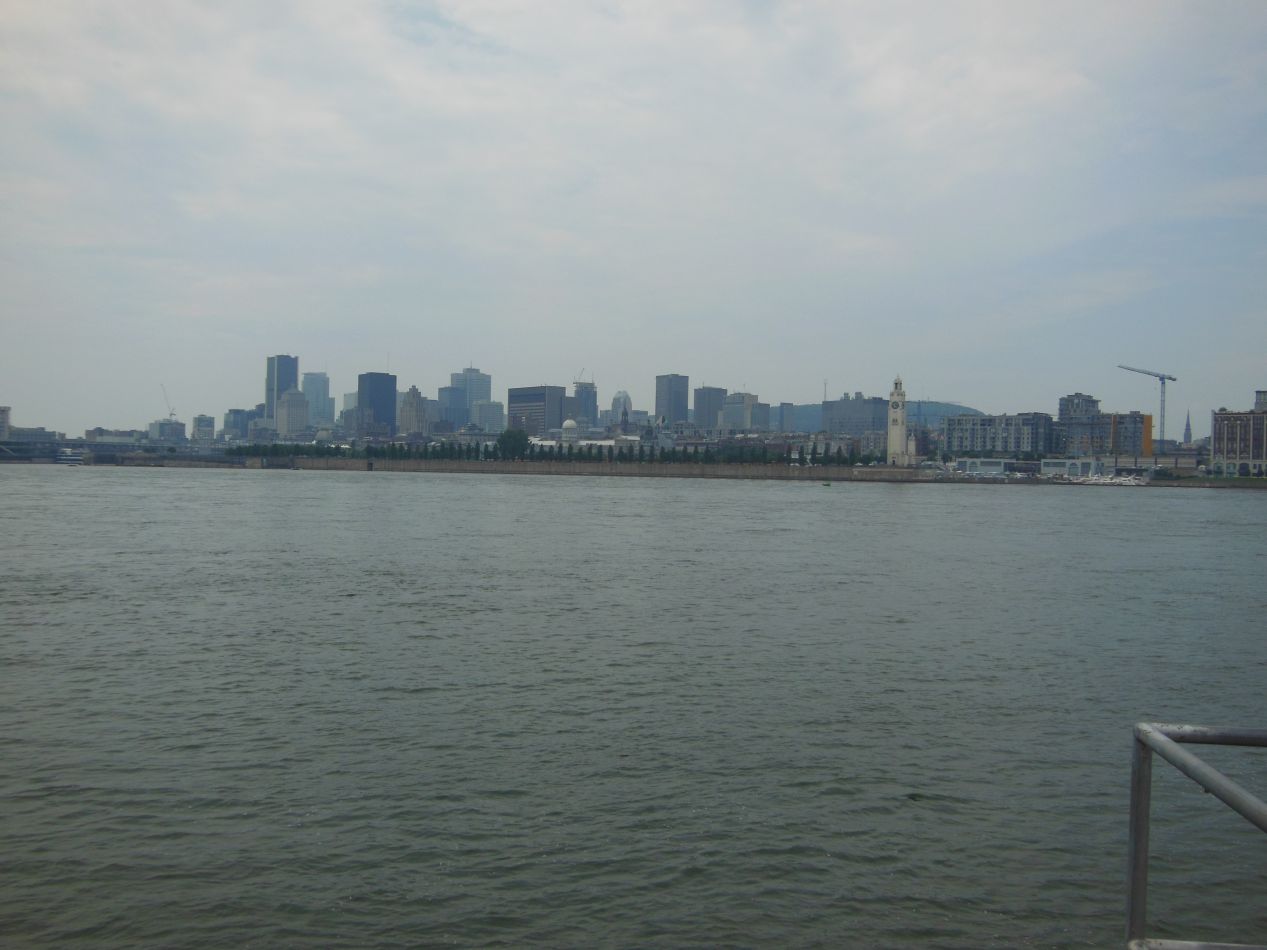


The next place that I chose to visit were a pair of islands located out in the Saint Lawrence River. Montreal itself is located on a large island in the river, but these two (Île Sainte-Hélène and Île Notre-Dame) are much smaller and mostly covered by green parkland. This area is official known as Jean-Drapeau Park, named after a former mayor of Montreal who was instrumental in having the 1967 World Expo hosted in the city. The biggest attractions on the islands are an amusement park called La Ronde, described as being similar to Six Flags, and a huge casino that takes up most of the space on the eastern island. I had taken the subway over to Île Sainte-Hélène, and took the above pictures looking west across the Saint Lawrence back towards the Old Montreal district that I had just visited. The white dome of the Bonsecours Market was visible in one of the pictures, while further downriver a large Molson brewery poked up above the skyline. This was a pleasant day to stroll around the paths on the island between the trees, although I do recall that it was quite hot outside. The last picture comes from a historical attraction located on Île Sainte-Hélène, a museum dedicated to preserving Fort Stewart. The museum tells the early history of the city of Montreal, and I probably should have gone inside to see the displays. Instead, I spent the next two hours wandering around on the islands in semi-lost fashion, which was not the best use of time or energy on a hot day.




The most unique attraction on the islands was this structure, the Montreal Biosphere. This was an attraction built for the 1967 World Expo held in the city of Montreal, a huge geodesic dome designed and built by Buckminster Fuller. It was originally enclosed within a transparent acrylic bubble, but the outer shell was burned away in a fire that took place in 1976 and only the framework of the structure survived. Today the dome is an environmental museum dedicated to showcasing the ecosystem of the Great Lakes region. The Biosphere stands 60 meters (200 feet) tall and serves as an easily-recognizable landmark, visible from anywhere on the two islands and from the downtown portion of Montreal across the river. I walked through the Biosphere - literally, since the path takes visitors right through the dome - and had a chance to get a good look from close up. The most similar structure that I can think of is the Spaceship Earth pavilion at Epcot in Disney World, which was similarly inspired by a geodesic dome. This is a pretty wild building and interesting to visit, although it's a bit hard to reach since it's way out in the middle of the islands.


I did check out the Montreal Casino as well, since it was nearby on the Île Notre-Dame. This is a gigantic casino, the largest in Canada, and it contained the usual assortment of slot machines and table games. I would have taken pictures of the inside but their policy was not to allow photography. In retrospect, it was a mistake to spend some of my limited time over at the casino. I don't gamble and I don't enjoy casinos very much; there's something depressing watching people of modest means spending their money on games where they are rigged to lose most of the time, all done to fatten the pockets of those who are already exceedingly wealthy. I get that a lot of people enjoy these games of chance, and it's certainly within their right to do so, but they're not for me.

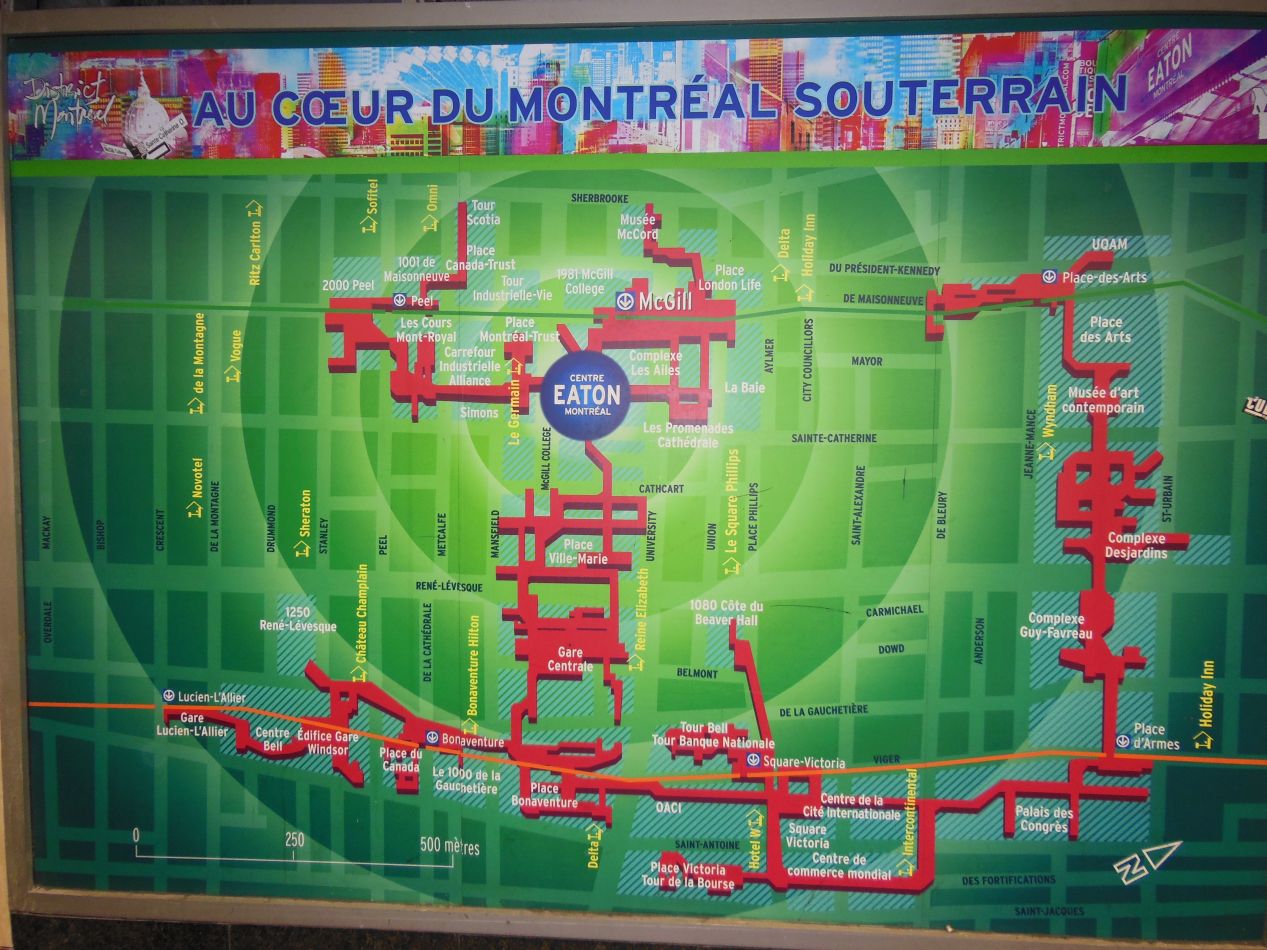


From the casino, I had a long walk back to the closest metro stop, and then took a train back into the center of the downtown again. My next stop was in the Montreal Eaton Centre, the heart of a lengthy network of underground tunnels that join together to form a gigantic shopping mall. This is one of the ways that the city has adapted to the cold winter climate, creating this series of passageways where shoppers can walk for miles on end without ever having to venture outside. Known unofficially as the Underground City, there are about 32 kilometers (20 miles) of these tunnels in all, which sprawl throughout the central business district of Montreal. I included a picture of a map above to demonstrate how far they reach. The Eaton Centre is the area with the highest concentration of retailers, with six total floors that reach both above ground and well below surface level. The perspective alone was dizzying where I could stand and see five or six floors at once stretching down below me. Although I wasn't here to shop, I did get lunch at the mammoth food court captured in the last picture above. I wasn't quite able to showcase the scale of the place, but trust me, there were about 30 different places selling food in this circular area, offering up virtually any type of cuisine desired. For anyone interested in shopping on their trip, this would be the place to visit.

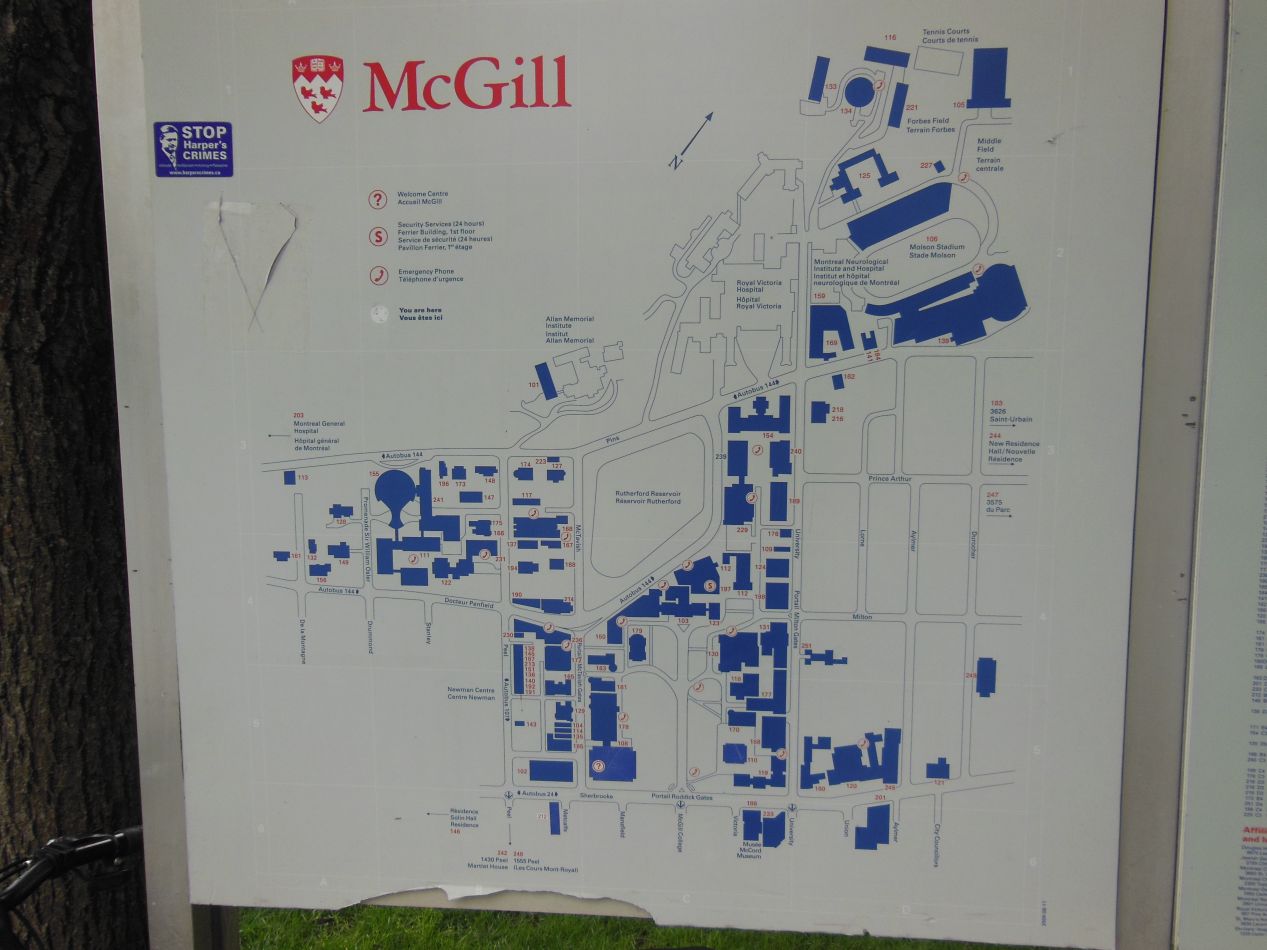


The underground tunnels of the shopping mall carried me onwards to McGill University, arguably the most prestigious university in Canada. This college was initially founded in 1813 and received a royal charter shortly thereafter, named after Montreal merchant James McGill. At the time of writing, the university had around 40,000 enrolled students located on a downtown campus of 80 acres. McGill boasts innumerable famous alumni from all walks of Canadian society, with this list provided on the university's Wikipedia page: 12 Nobel laureates, 144 Rhodes Scholars, 5 astronauts, 3 Canadian prime ministers, the incumbent Governor General of Canada, 14 justices of the Canadian Supreme Court, 4 foreign leaders, 28 foreign ambassadors, 9 Academy Award (Oscars) winners, 11 Grammy Award winners, 3 Pulitzer Prize winners, and 28 Olympic medalists. Needless to say, this is a bit of an elite institution.
The McGill campus was situated at the foot of Mont Royal, and it was quite hilly walking between the buildings. Like most college campuses, the immediate area was quiet and covered with lots of overhanging trees. There was virtually no one around since it was summer, and unlike a lot of American colleges that often seem to be trying to win a popularity contest, the buildings at McGill were generally nondescript structures of stone and brick. This wasn't the prettiest university campus that I had seen, but perhaps that's because it didn't have to be. That said, having Mont Royal park so close to McGill would be really nice for anyone attending. I also stumbled across Percival Molson Memorial Stadium while walking through the campus, the football stadium that plays host to both the university's sports teams and the Montreal Alouettes of the Canadian Football League. It says something about the CFL that one of its oldest and most successful teams plays its games in a college stadium that only seats 24,000 fans. Still, I'm not trying to knock the place, this looked like a pleasant place to watch a sporting event. The point is more that hockey holds the overwhelming top spot for Montreal sports fans, and the Canadiens are roughly a thousand times more popular than the Alouettes.

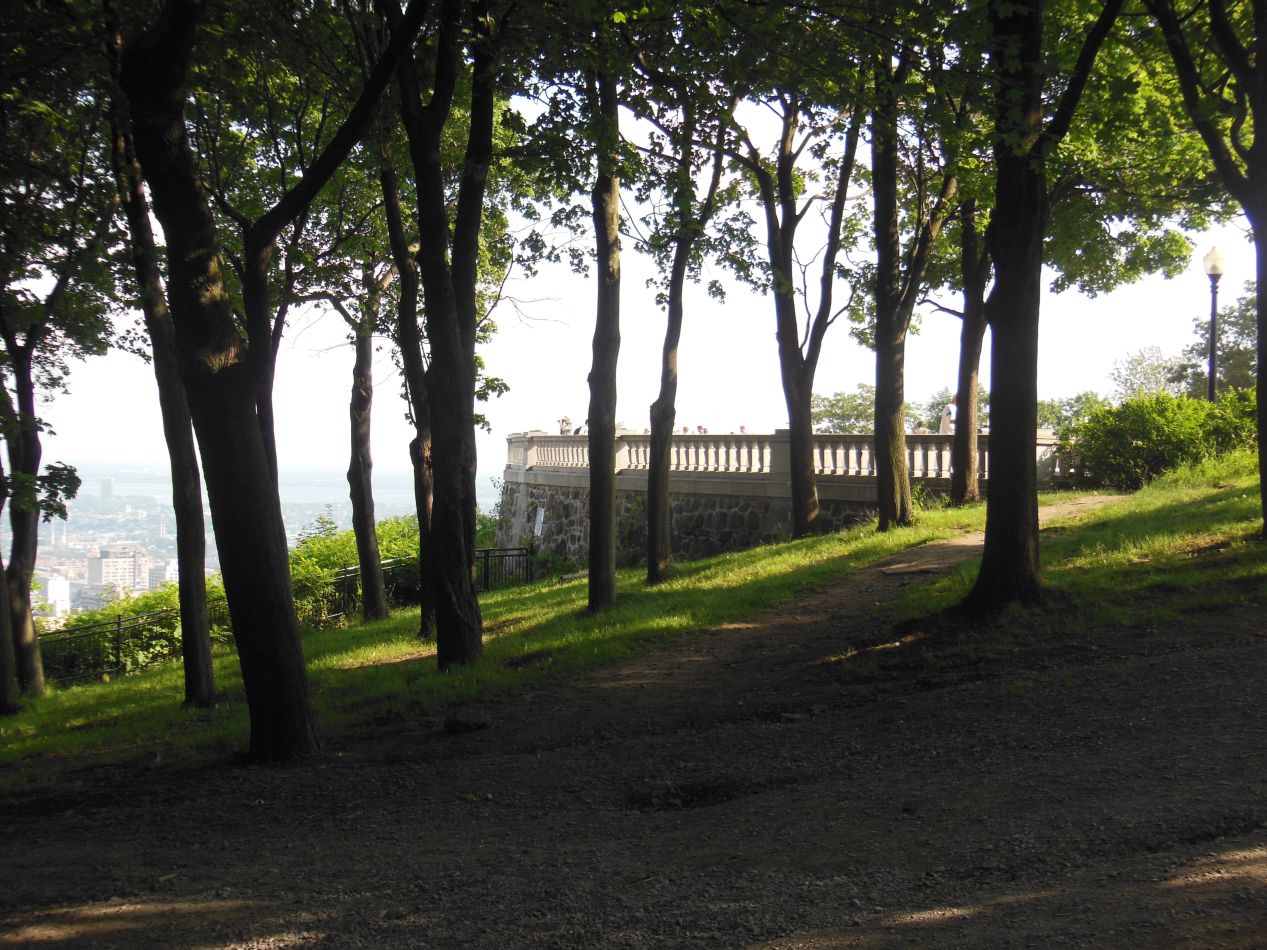


The last place that I was headed on this day was the Parc du Mont Royal (Mont Royal Park), one of the most famous and beloved attractions in the city of Montreal. This is a huge 692 acre park situated in the heart of Montreal, much like Central Park in New York. Unlike Central Pak, however, Mont Royal encompasses a large hill that rises up above the rest of the city and provides sweeping vantage points looking out in every direction. In an act of great foresight, city planners decided that Mont Royal would become a public park in 1876 and kept it free of development in the decades since. The whole park is crisscrossed with dozens of walking and biking trails, and it's the most popular place in Montreal for exercise and outdoor activity. There's even snow tubing and tobogganing here in the winter when the hill is covered with snow. I thought this would be an appropriate place to end the day's traveling.
Unfortunately, I had done so much walking during this hot summer day that I was completely exhausted. Instead of doing some hiking on the trails as I had planned, I was only able to walk to the Kondiaronk Belvedere, a semicircular plaza overlooking the downtown portion of the city. This is also the home to Mont Royal Chalet, a pavilion constructed in the 1930s that can host indoor or outdoor events for several hundred people. The interior was indeed very reminiscent of a structure from the Swiss or German Alps, from the wooden beams overhead down to the heraldric symbols over the fireplace.

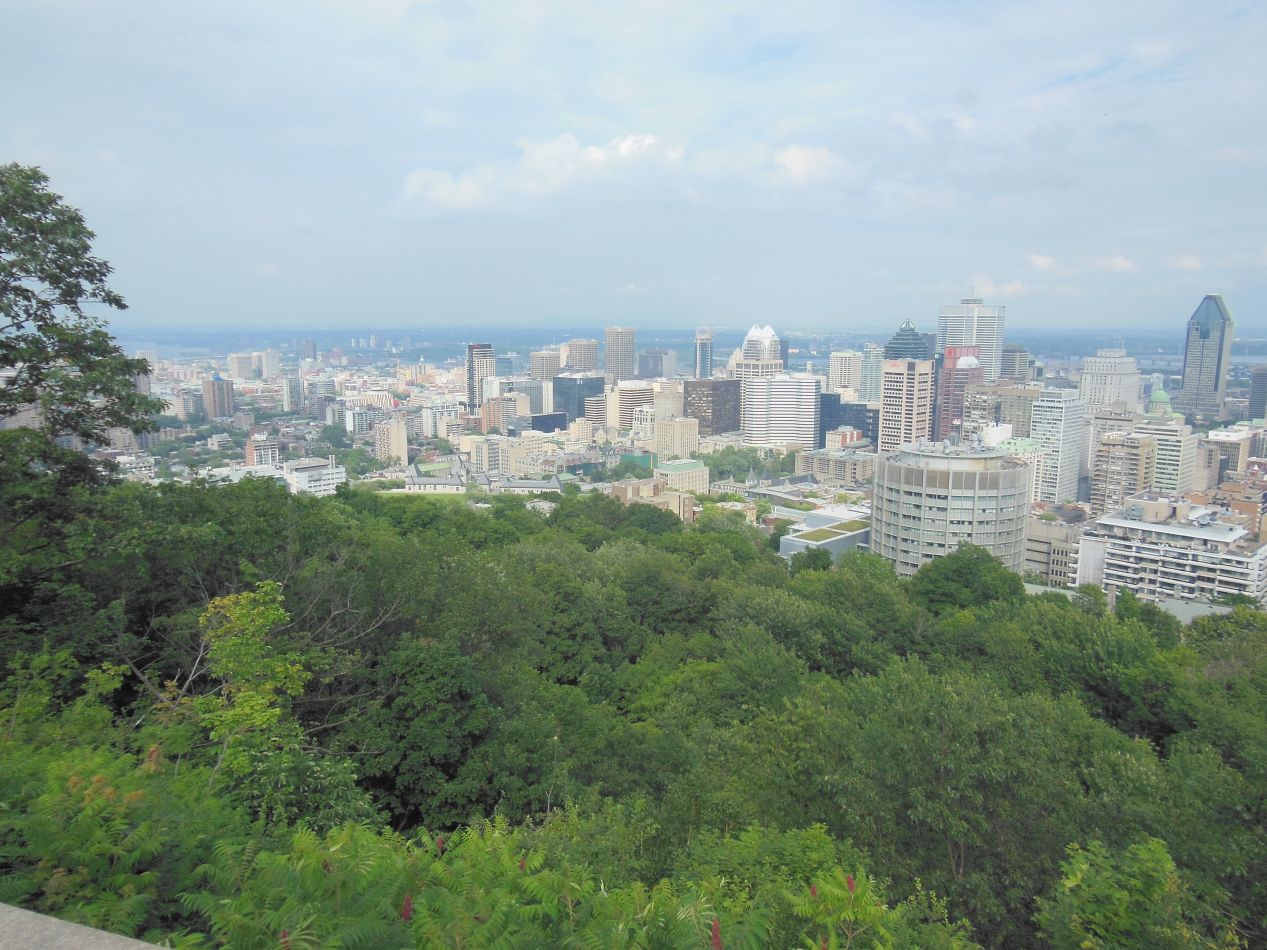


This was the view looking out over the city from the plaza in front of Mont Royal Chalet. The oldest buildings in the Old Montreal district were blocked by newer construction, but I could see far off into the distance both to the north and south. Montreal is a city that spreads out a good bit rather than having too many enormously tall skyscrapers, perhaps due to the winter climate. This is one of the economic and cultural hearts of Canada, and the epicenter of the French Canadian community in Quebec. There was only one downside to being up here on this overlook: I still had to walk all the way back to my hostel for the night, and that was a good distance away. Sigh. 

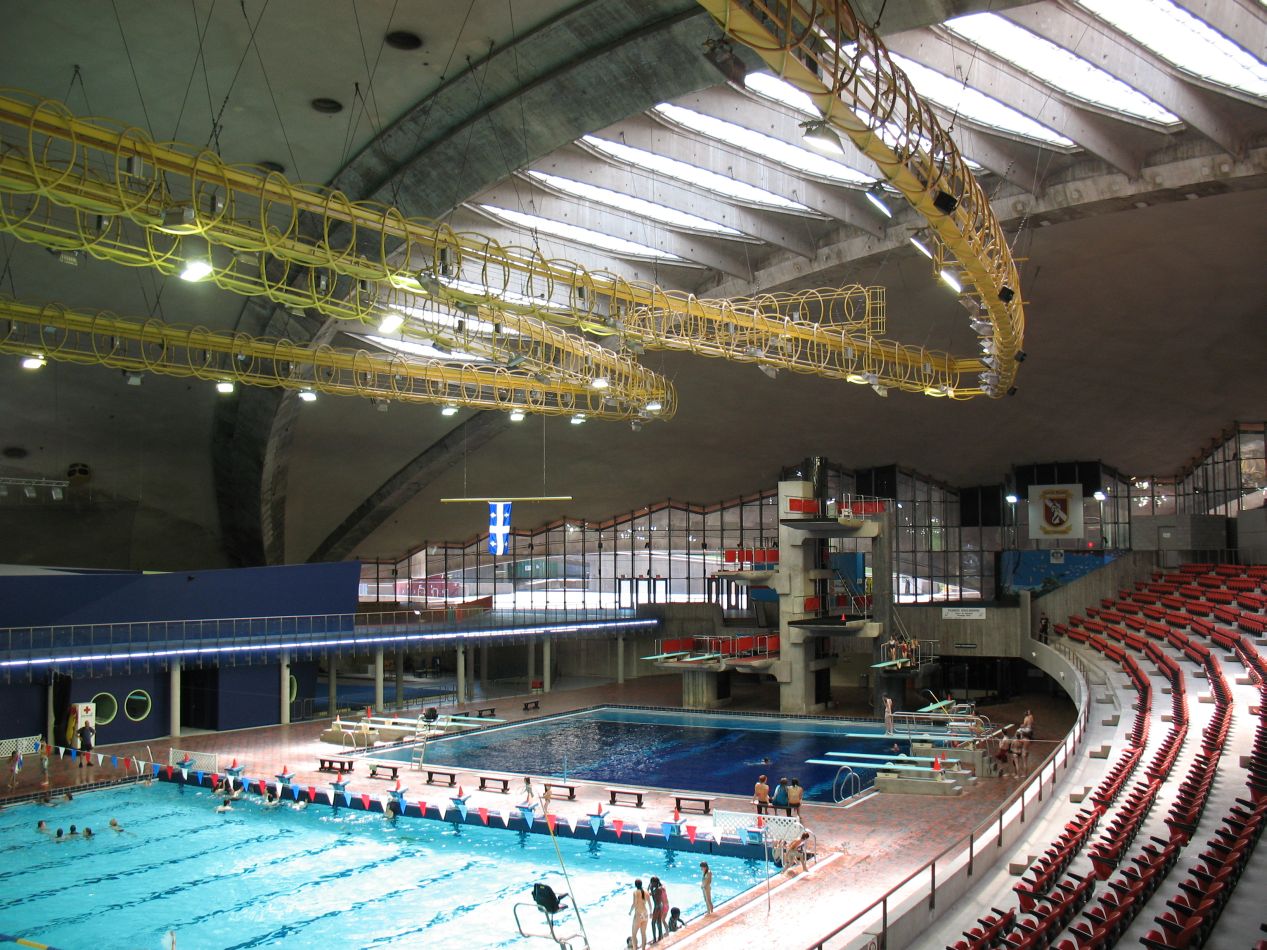


Bonus picture time! On my previous trip to Montreal in 2007, I had the occasion to visit the Stade Olympique (Olympic Stadium), the home to the 1976 Summer Olympics. This building is situated a good bit to the north of downtown Montreal and stands out for its distinctive tower overlooking the otherwise circular stadium. Olympic Stadium has had a reputation as a financial boondoggle due to the high cost of hosting the Olympics, although it later spent decades hosting the games of the Montreal Expos and the Alouettes as well as concerts of all sorts. It probably doesn't deserve its reputation as a money sink. When I visited Olympic Stadium, I had the chance to see the swimming venue where the games were held back in 1976. The area was almost shockingly low-key, a far cry from the elaborate spectacles that the modern Olympics seem to demand. The whole place was being used as a public pool for nearby residents of the city. The main park of the stadium was being set up for a monster truck rally when I visited, with big dirt ramps covering the central area. It was kind of sad to see the stadium going unused for anything beyond concerts and events; this place was host to the Expos for almost three decades and it's a shame that no major team has returned since. Granted, Olympic Stadium was a terrible venue for baseball games, but because it was so awful it had its own unique charm. The Blue Jays have been playing a couple of preseason baseball games here for the last few years and that's a nice gesture from their organization.




These are some pictures taken from the top of the tower at Olympic Stadium. There's an observatory at the top that can be reached via a funicular, where visitors are treated to sweeping views of Montreal from a height of 175 meters (575 feet). From here, I could see the downtown part of the city in the distance to the south, as well as the two smaller islands in the river with the roller coaster tracks of the amusement park rising up above the trees. While these pictures were taken on a different trip entirely, I can pretend that I was taking in another overview of the city from this high vantage point.


Anyway, back to the present trip from 2013. I was staying at this hostel known by its French heading of "Auberge de Jeunesse", a phrase that for some reason always kept appearing when I was taking French classes in school. Well, I did get a real world chance to use that knowledge after all, heh. This place was pretty nice overall, with the standard communal sleeping rooms and a bar area down in the basement. I remember this place distinctly because it was where I had to alter my travel plans for the rest of the trip. My original plan had been to drive the Trans-Labrador Highway through Labrador City and Happy Valley-Goose Bay, then take the short ferry over to Newfoundland from the southern tip of the Labrador Coast. However, at the time of this trip there were raging wildfires burning out of control that had shut down the Trans-Labrador Highway. I had been hoping that would clear up, but by this evening it was obvious that that wasn't going to happen and I would be unable to travel on my planned itinerary. I ended up canceling my hotel reservations in Labrador and booked a different ferry ticket, taking the Nova Scotia to Newfoundland route instead. This was a real disappointment as I was going to have to miss the most remote part of my journey, the drive through the central part of Labrador. These things happen sometime though, and I couldn't do anything about giant wildfires. I simply had to make the best of the situation.
The next day's travel would remain the same, however. I was heading to Quebec City, one of my top destinations to explore on this trip. The hilly walled city was the site of one of the most famous battles in North American history, and I'd been eager to see it in person for many years. My trip through Canada continued onwards, always heading further and further to the east.



